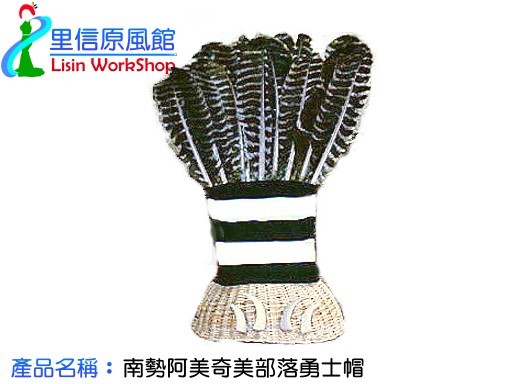2001年,一堂原住民的服飾文化課程,邀請里信到東華大學分享,從阿美族服飾解析部落文化的重現。這堂是很特別的經歷,也是里信第一次到高等學府擔任外聘講師。里信很常講的話:「我從小學因為家境清貧就肄業了,認得字沒幾個,怎麼可能說得清楚。」但這堂課結束後,因著女兒的幫助,順利完成授課,里信感謝課堂老師幫忙轉譯(因為有些用詞遣字學生可能聽不懂),也鼓勵在場的原住民學生說:「如果我能盡力去完成這堂課,你們也可以用自己有的能力,為部落文化盡一份心力!」
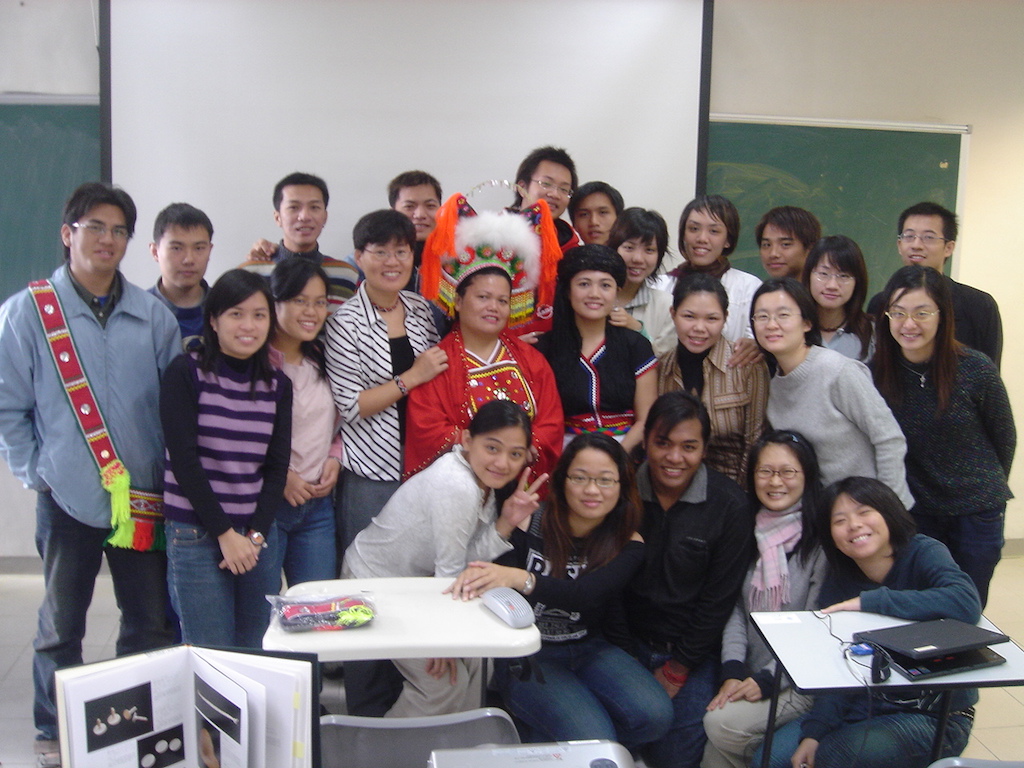
課堂前的暖身,里信為女兒穿上了,阿美族早期婦女的服裝。這套服裝的配色,就是過去小里信記憶中的黑色服裝,頭上髮髻布巾包裹,及簡單的布邊刺繡,S彎邊(胸前的布邊及腰上)也是後來設計的圖騰。里信說:「那時代普遍都窮,稍為有錢的家庭才有多一點的裝飾,買紅色的布料,大部分都是碳粉染色的黑布料,過去傳統的婦女就是這麼穿的。」
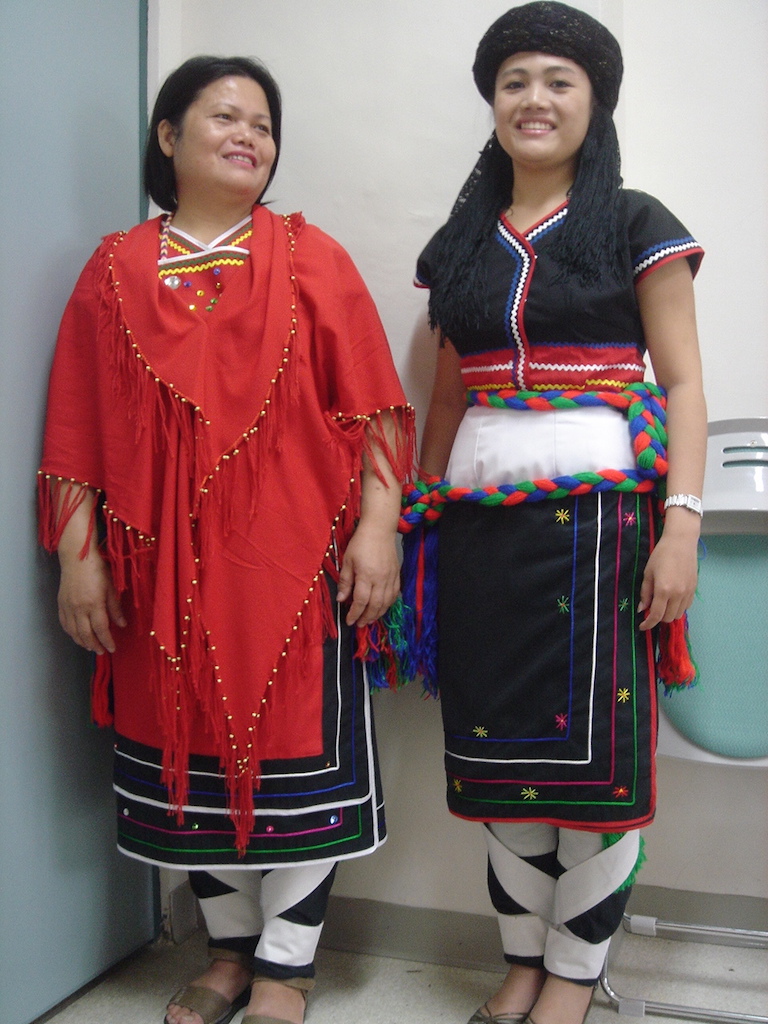
課堂上,身為花蓮縣瑞穗鄉奇美/Kiwit部落的里信,說著傳統的阿美族女性頭飾(“頂貝”阿美族口語說的頭飾),其實沒有現今這麼多花俏的蝴蝶結及吊飾,有的是白色的羽毛及傳統珠珠的流蘇,整頂花帽是用鐵片及鐵絲固定,相當的沈重。之後由於手工及材料的精進,現在的花帽越做越輕,越來越花俏。花帽代表女子花樣年華,能歌善舞,溫慧嫻熟,能照料家庭的年紀,期待如意郎君的親睞。另外,傳統的阿美族男子在成年禮時,會有一個儀式,當男子通過部落耆老設下的種種考驗,他會將男子從家中帶來母親的花帽,帶在他的頭上,並將豬油塗在他臉上,並意思性地在他的會陰部前方輕拍,代表他已經適婚年齡,可以讓部落婦女挑選的女婿。
備註:因為阿美族是母系社會,所以家中若是女子待字閨中,女子的母親會在豐年祭時選女婿,當男子有意成為女婿時,會讓母親將檳榔放在男子的情人袋裡,而男子的父母親及部落媒人在祭典結束後,會前往女子家中提親。未來若男子不符合家中要求,仍由女方家族行使休夫制。看起來像入贅,但也不完全像,因為南島民族有一部分的民族仍是以母係社會為主。
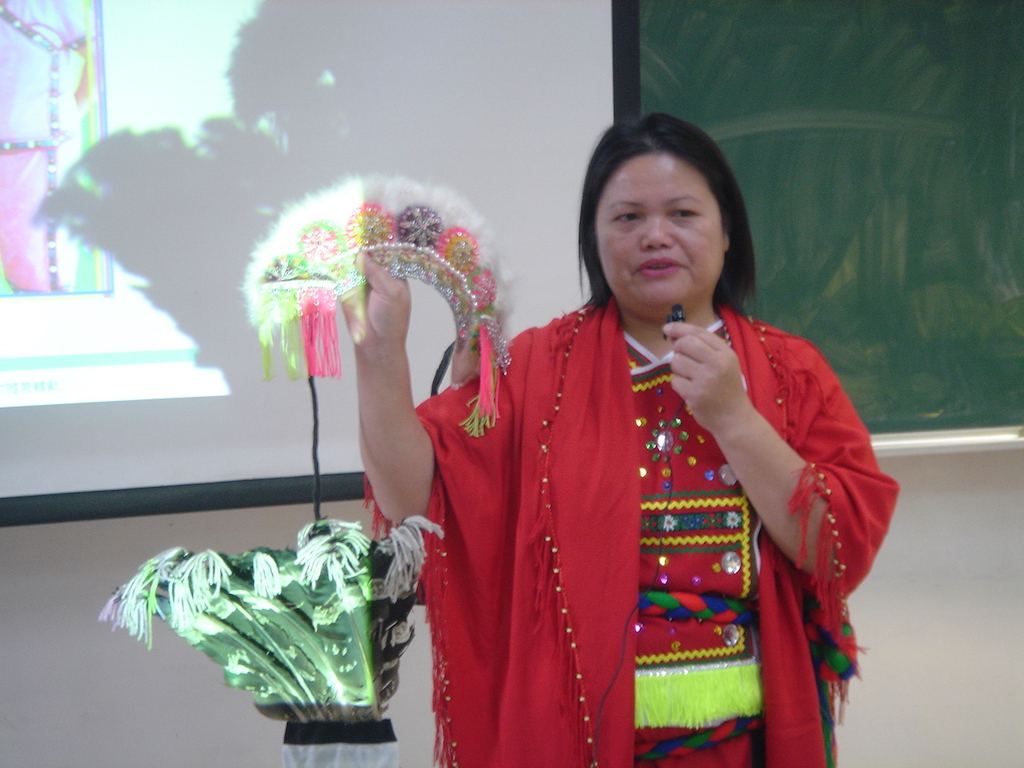
每個部落的代表男性頭飾各有不同。像花蓮市七腳川部落有名的頭飾是1排七支大羽毛,中間1支長度最長,像極的避雷針的勇士毛;而奇美部落的代表頭飾則是老鷹羽毛的勇士帽。因為奇美位於奇萊山群的山腰上,位居高山上,常有老鷹盤旋獵食。而部落的男子在適婚年齡前,必須承接保衛部落的責任,而這個責任就在這些勇士身上,部落耆老希望他們有像老鷹一樣的體力、堅忍力、魄力及嚇阻力,故勇士帽就以老鷹的羽毛當作象徵,亟盼部落的勇士能有老鷹的膽試,能像老鷹一樣穿梭部落成為防護。額頭上的山豬牙,也象徵著部落勇士有狩獵的基本能力,能養活家族,即將成年的象徵。
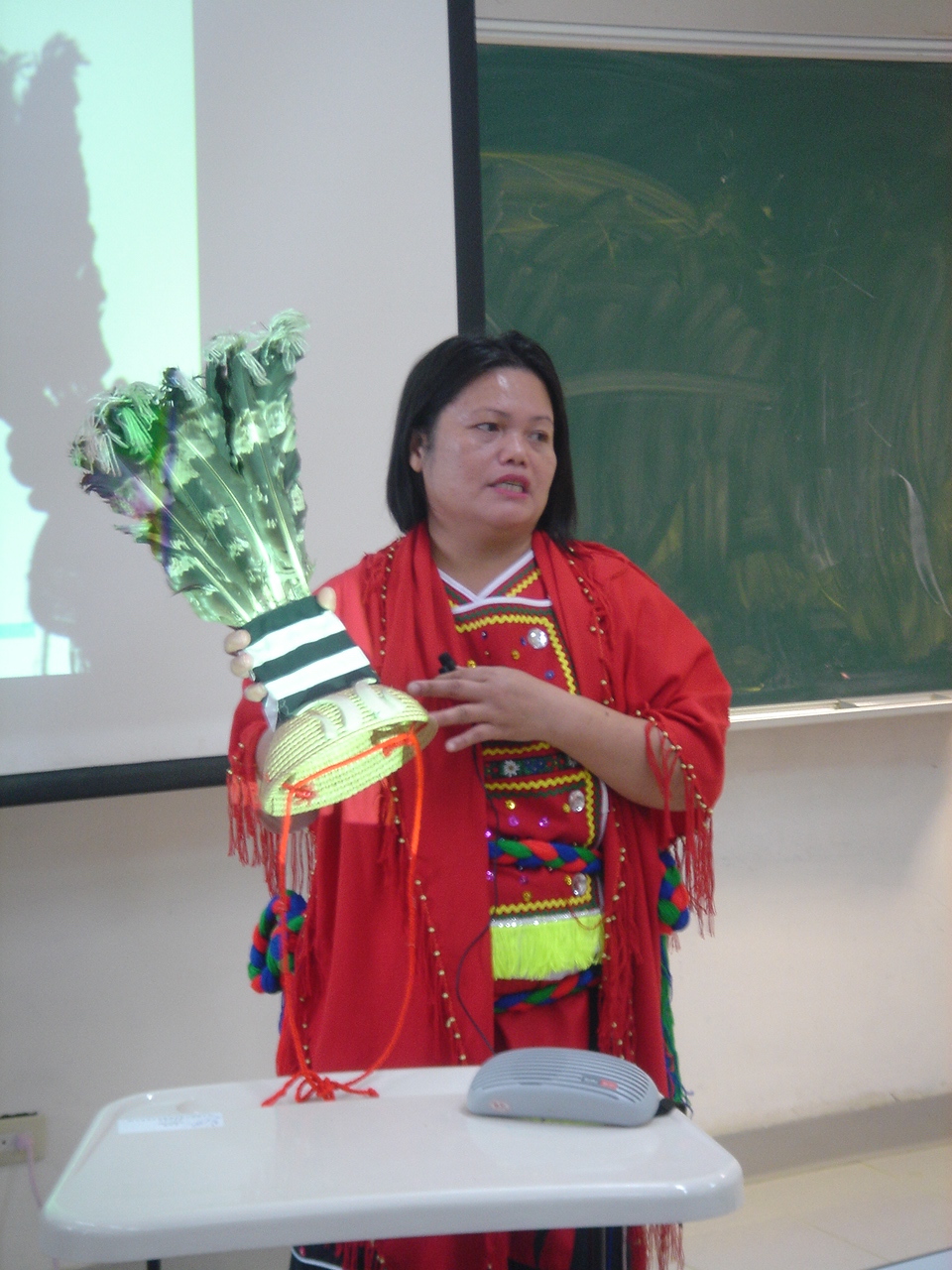
里信與授課的老師照相留念!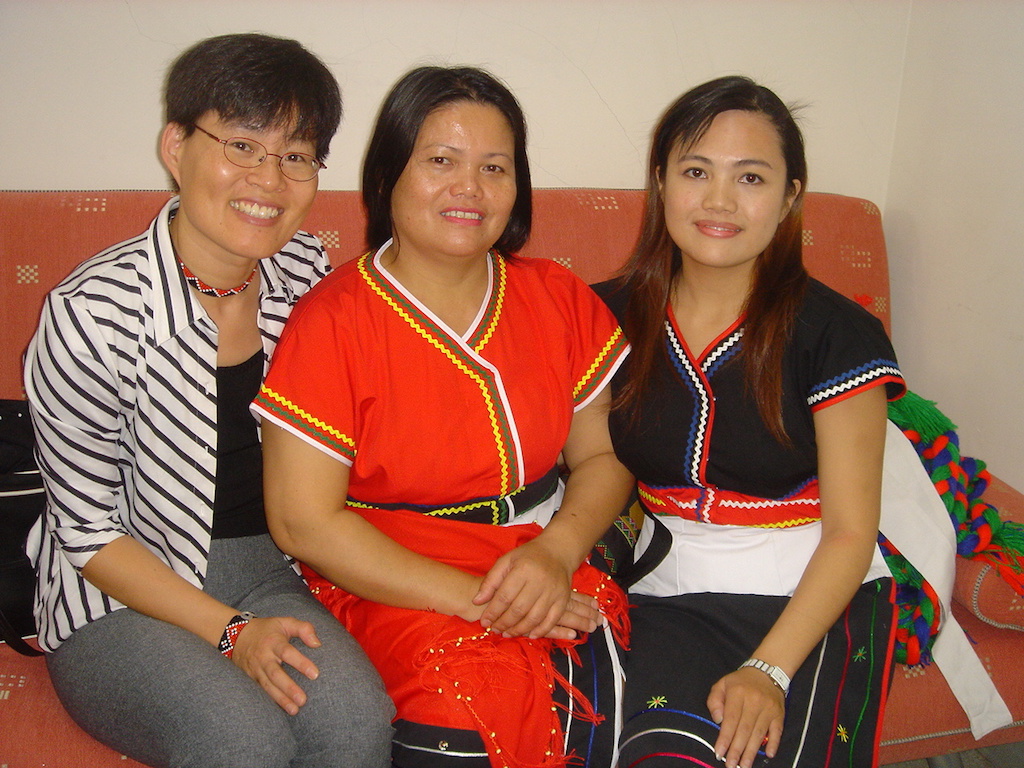
課程短片:
1.打麗是什麼?
2.部落對白色的衣服代表的意義?
3.盤頭布巾的原因?
部落文化是一本很厚的故事書,是值得我們一起細細品嚐的。
里信芭閣娜,下期繼續挖掘她的故事。
(本文圖片下載使用前請徵求工坊意願!)
Sharing the Beauty of Indigenous Attire in 2001
In 2001, Lisin was invited to share her knowledge of indigenous clothing and culture at National Dong Hwa University, where she analyzed the revival of tribal culture through Amis tribal attire. This was a unique experience and her first time as a visiting lecturer at a higher education institution. Lisin often said, "I dropped out of school due to my family's poverty, and I don't know many words. How can I explain things clearly?" However, with the help of her daughter, she completed the class and expressed gratitude to the teacher for translating (as some terms may be unfamiliar to the students). She also encouraged the indigenous students present, saying, "If I can do my best to complete this class, you can also contribute to tribal culture with your abilities!
Before the class started, Lisin dressed her daughter in the traditional attire of early Amis women. The color scheme of this outfit was the black clothing that Lisin remembered from her childhood. The hair was tied up, and a simple embroidered border was added. The "S" curve (on the chest and waist) later incorporated traditional motifs. Lisin explained, "Back then, most people were poor, and only slightly wealthier families could afford more decorations. The majority of the material used was black, dyed with carbon powder. This is how traditional women used to dress."
During the class, as a representative from the Kiwit tribe in Ruisui Township, Hualien County, Lisin talked about the traditional Amis women's headdress ("top shell" in the Amis language). It didn't have the fancy bows and ornaments seen today; instead, it featured white feathers and traditional beaded tassels. The entire headdress was secured with metal sheets and wires, making it quite heavy. Over time, the hats became lighter and more elaborate, with improved craftsmanship and materials. The wreath symbolized the prime of a woman's life—being able to sing, dance, and take care of the family. It was hoped that a suitable husband would be attracted to her. Additionally, in the traditional Amis male initiation ceremony, when a young man passed the various tests set by the tribal elders, he would wear his mother's headdress on his head and apply pig oil to his face. Symbolically, he would lightly tap his perineum, indicating that he had reached the age for marriage and could be chosen as a son-in-law by tribal women(Note 1).
Each tribe has its representative male headdress. For example, the Cikaso'an tribe in Hualien City is known for a cap consisting of seven large feathers, with the center one being the longest, resembling a warrior's lightning rod. The representative headdress of the Kiwit tribe, on the other hand, is a warrior cap adorned with eagle feathers. As Kiwit is located on the mountainside of Mount Qilai, eagles often soar and hunt there. Before reaching the age of marriage, young men in the tribe must be responsible for defending the tribe. This responsibility rests on these warriors, and the tribal elders hope they possess an eagle's physical strength, endurance, courage, and intimidation abilities. Thus, the warrior cap uses eagle feathers as a symbol, hoping that the tribe's warriors can have the courage of an eagle, traversing the tribe to provide protection. The boar's tusks on the forehead also symbolize the basic hunting abilities of tribal warriors, who can provide for their families and are on the verge of adulthood.
- Note1: As the Amis people follow a matrilineal system, if a woman remains unmarried, her mother will select a prospective husband for her during the Harvest Festival. When a man intends to become a son-in-law, he will have his mother place betel nuts in the woman's lover's bag. After the festival, the man's parents and tribal matchmakers will visit the woman's family to propose. If the man does not meet the requirements set by the woman's family, the woman's family still has the right to divorce him. This may seem like a form of marrying into the woman's family. However, it is not entirely the same, as some indigenous tribes still primarily follow a matrilineal system.


